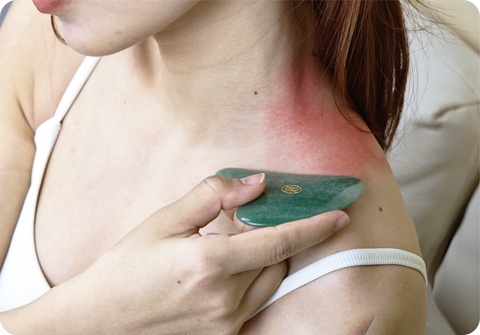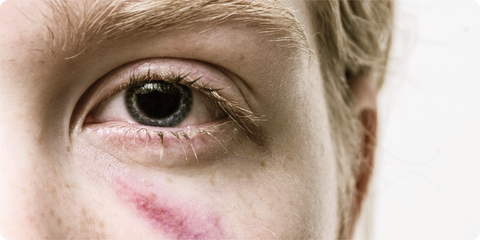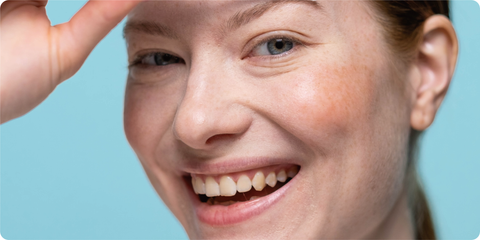Why Is My Face So Red After Gua Sha Massage? Expert Tips for 2023
Gua sha massage has become a popular at-home beauty technique for reducing wrinkles, sculpting contours, and relaxing facial muscles. However, many are caught off guard when their skin turns noticeably red after a gua sha treatment. This facial redness can be alarming for those new to the practice. However, it is a normal side effect indicating positive circulation effects from the massage technique.

Let's explore why gua sha causes facial redness, whether it's normal, when you should worry, and how to minimize redness from your gua sha practice.
What Causes Redness During Gua Sha?
Gua sha massage relies on short, pressured strokes applied to the skin using a smooth-edged tool like jade or rose quartz. This creates friction against the skin that can cause mild inflammation and capillary breaks under the surface, resulting in diffuse redness.
Specifically, the increase in blood circulation and release of blood stagnation creates redness. Gua sha allows fresh oxygenated blood to flow to facial tissues and muscles. Toxins and metabolic waste are also drained through the lymph system, producing redness.
This mechanism is exactly how gua sha produces its beauty and health benefits. So, some minor redness is expected and a sign the treatment is working properly by increasing blood flow.

Is Facial Redness Normal With Gua Sha?
Yes, mild to moderate facial redness is a normal side effect of gua sha massage. The redness should present as a general flushed appearance across the areas you treated. It may be more noticeable along the lymphatic drainage pathways around the nose, eyes, and cheeks.
The redness should dissipate within a few hours after your gua sha session. Some residual pinkness or splotchiness may last up to 24 hours. But it should fade relatively quickly.
This temporary reaction does not indicate any damage occurred to the skin. Quite the opposite - the redness demonstrates the gua sha opened circulation, drained built-up toxins, and brought fresh blood to your facial tissues.

When to Worry About Gua Sha Redness?
While normal redness following gua sha is no cause for alarm, be on the lookout for adverse reactions that may indicate you need to adjust your technique:
- Redness lasting longer than 24 hours
- Localized redness rather than a general flushed appearance
- Bruising, broken capillaries, or petechiae (red dots)
- Tenderness, swelling, pain, or increased skin sensitivity in areas
- Redness accompanied by headache, nausea, dizziness, or other symptoms
If you experience any adverse reactions, take it as a sign to lighten up your gua sha pressure. Allow your skin to rest a few days before your next facial massage session.
Tips to Prevent Excess Facial Redness
Proper technique can minimize excessive redness over time as your skin adjusts to gua sha massage. Here are some tips:
- Use lighter pressure, especially when starting. Better to underdo rather than overdo.
- Focus on slow, relaxing strokes rather than short, scraping motions.
- Keep skin moisturized before and after gua sha to reduce friction.
- Allow days between gua sha sessions for circulation to normalize and for the skin to recover.
- Stay well hydrated before and after to support toxin flushing.
The Benefits Behind the Redness
While facial redness may cause initial concern, understanding the mechanisms behind it provides reassurance that gua sha is working to improve your complexion:
- Increased blood flow brings oxygen, nutrients, and hydration to skin cells.
- Lymphatic drainage reduces puffiness by removing accumulated toxins.
- Collagen production ramps up to support skin health.
- Skin becomes more radiant as circulation increases long-term.
- Muscle tension is released due to flushing of tissue and relaxing strokes.
- Any pain or soreness from muscle knots diminishes.
So remember, temporary redness from gua sha massage is normal and not necessarily a bad reaction. With proper technique and aftercare, your skin will adjust to reap the full benefits of radiance-boosting facial massage.
Conclusion
Gua sha massage typically causes facial redness, but this is normal and not harmful. The redness comes from increased blood circulation to the skin's surface during the massage. This improved blood flow provides benefits like brighter, more radiant skin, drainage of fluid buildup, and relaxation of tight facial muscles.
It's expected to have mild, temporary redness for up to 24 hours after gua sha. This shows the technique is increasing blood flow as it should. Extensive or long-lasting redness could mean you're applying too much pressure.
To prevent overdoing it, go gently when starting, keep your face moisturized, stay hydrated, and space out gua sha sessions. With practice, your skin will adjust to the massage. Over time, the short-term redness will give way to noticeably improved skin: less puffiness, smaller pores, fewer wrinkles, and a healthy glow.
So, in summary, don't be alarmed by some flushed skin right after gua sha. Think of it as a sign that your massage technique stimulates circulation. You'll progress towards more radiant, youthfully contoured skin with routine practice.
Read More
- Relieve Stress and Pain Naturally with Gua Sha Therapy - Learn How to Use Jade Gua Sha Tool for Optimal Results – Rena Chris
- Michelle Yeoh made history – Rena Chris
- What Kind of Skin Type Can Use Facial Gua Sha? – Rena Chris
- Unlock the Power of Jade Gua Sha for Optimal Health and Radiant Skin – Rena Chris
- High-End vs. Low-Cost Gua Sha Tools: Is It Worth Investing More – Rena Chris
